Hisense 65U7A Review
Hisense 65U7A
Great SDR picture performance and cracking value
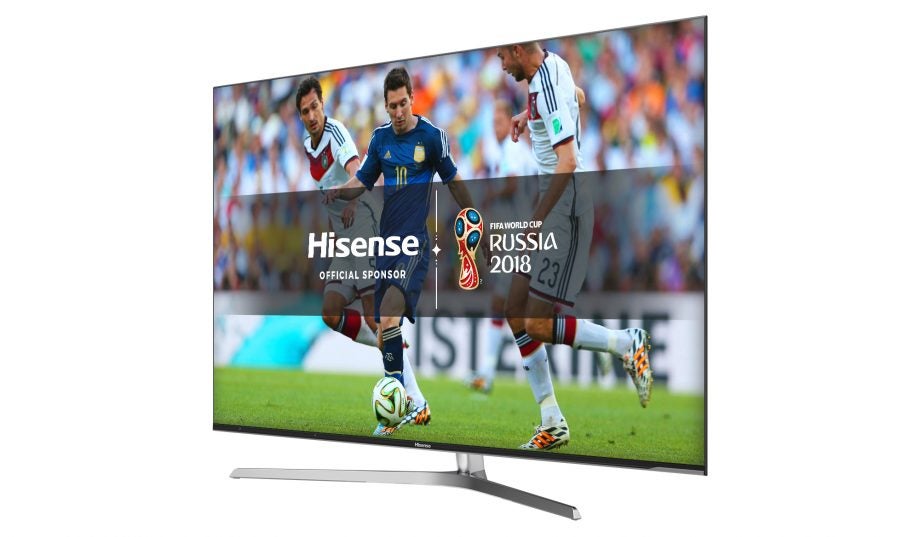
Verdict
Pros
- Good SDR picture quality
- Solid smart platform
- Decent video-streaming support
- Excellent fit and finish
Cons
- Lacklustre HDR performance
- Only two HDMI 2.0 inputs
- Limited viewing angles
Key Specifications
- Review Price: £1199
- 4K UHD TV with HDR10 and HLG support
- Freeview Play with integrated catch-up
- Auto Sport detection viewing mode
What is the Hisense 65U7A?
The Hisense 65U7A is the company’s latest mid-range 4K Ultra HD LCD TV. It’s also the official TV of the World Cup: eagle-eyed viewers might have spotted banks of U7As in the VAR booth during matches. Soccer sponsorship and a suitably FIFA-themed boot-up screen aside, this new UHD TV also supports both HDR10 and HLG, boasts an attractive design, and has a surprisingly solid level of build quality considering its price.
There are three screen sizes available: the 50-inch H50U7AUK; the 55-inch H55U7AUK (read the review); and the 65-inch H65U7AUK reviewed here. At a suggested retail price of £1199, the 65U7A certainly looks like a bargain. However, can it put one in the back of the net when it comes to performance.
Related: Best Budget TVs
Hisense 65U7A – Design
The Hisense 65U7A might be a relatively cheap TV, but you’d never guess by simply looking at it. Its elegant design is reminiscent of a flagship Samsung from a couple of years ago, especially the boomerang-shaped stand.

The minimalist styling and bezel-less screen are both eye-catching, as is the silver finish and largely metal construction. Hisense certainly knows how to put a TV together, and the quality of construction is genuinely impressive. The back of the stand uses a metal column to support the panel, giving the impression that it’s floating in mid-air.
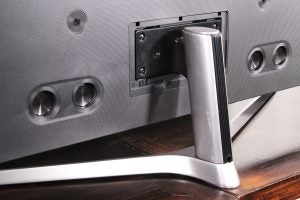
The connections comprise four HDMI inputs: two are full bandwidth HDMI 2.0 with support for 4K/60p, while the other two are 4K/30p. One of the HDMI inputs supports ARC (Audio Return Channel), and another supports MHL (Mobile High-Definition Link).
The fact that the 65U7A is limited to two HDMI 2.0 inputs is a shame, and means that if you have three or more devices that support 4K/HDR then you won’t be able to attach them simultaneously. However, such a limitation is more acceptable on a TV at this price point, than it is on a flagship Sony or Panasonic TV.
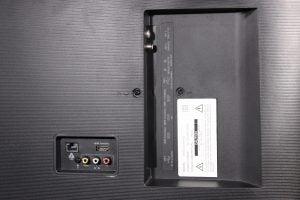
There are also three USB ports (two 2.0 and one 3.0), a Freeview HD tuner, a generic satellite tuner, an optical digital input, and a CI (Common Interface) slot. Finally, there’s an Ethernet port; the 65U7A also includes built-in Wi-Fi.
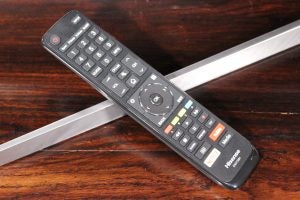
Hisense has included its standard controller, which is rather large but at least comfortable to hold. The buttons are fairly big, but clearly labelled and sensibly laid out. There are all the keys you’ll need to control the 65U7A, along with a home key for accessing the VIDAA Smart TV system, and direct access buttons for Netflix, YouTube and Media content.
Related: Best TVs
Hisense 65U7A – Features
Despite its relatively low price, the Hisense 65U7A boasts a decent set of features. Naturally, it uses a 65-inch 4K Ultra HD (3840 x 2160) VA (vertical alignment) LCD panel with a 120Hz refresh rate. There’s edge LED backlighting along the bottom, and the 65U7A also employs local dimming.
The Hisense supports a wider colour gamut, although the LEDs themselves don’t use quantum dot. It also doesn’t support full 10-bit. Instead, it uses 8-bit + FRC (Frame Rate Control) dithering, but it can accept content that uses 10-bit.

The 65U7A supports High Dynamic Range, specifically HDR10 and Hybrid Log-Gamma (HLG). However, despite including Dolby Vision in the US, it’s nowhere to be seen here. Publicly Hisense has said it will support the other dynamic metadata format HDR10+ in Europe, but when I asked the company if there was an HDR10+ update for the 65U7A, it said there were no plans to add the feature this year.
The 65U7A also includes Hisense’s Ultra Smooth Motion, which is a frame interpolation feature. This is handy for watching fast-paced sports broadcasts, but the Hisense has another trick up its sleeve. When the TV detects a sports broadcast on its internal tuner, it offers you the option of selecting the Sports mode.
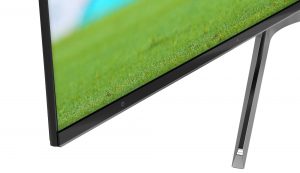
The VIDAA smart platform includes Netflix, Amazon and YouTube, with all three supporting 4K and HDR. In addition there’s Freeview Play, which provides access to all the UK TV catch-up services, and the BBC iPlayer app also supports 4K and HLG.
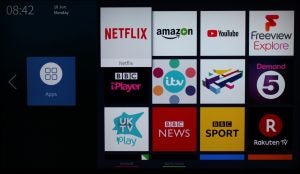
If you’re a gamer, you’ll be glad to hear that the 65U7A has a dedicated Game mode setting, which bypasses much of the processing and delivers an input lag of 31ms. That should be low enough for even the most demanding gamer, and it applies whether you’re gaming in 1080p, 4K, SDR or HDR. You’ll definitely need to use the Game mode; if you don’t the lag is 56ms, which would be noticeable to hardcore gamers.
Related: Netflix vs Amazon
Hisense 65U7A – Smart platform
The Hisense 65U7A uses the company’s VIDAA Smart TV platform, which is fairly basic in its appearance but actually quite effective in operation. You access VIDAA by pressing the Home button on the remote, which offers the option of choosing tiles for Freeview Play, Apps, Inputs, Media and Settings.
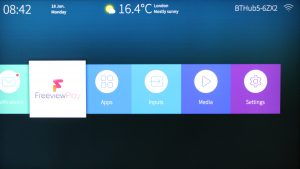
The system overlays these tiles onto the picture, and is both robust and responsive thanks to quad-core processing. As well as accessing the system using the Home button, you can directly access Netflix, YouTube, Media, Inputs and Settings using dedicated buttons on the remote.
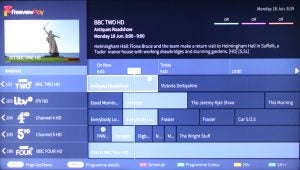
The TV includes an EPG (Electronic Programme Guide), which you can also access directly from the remote control. The guide displays six channels over a three-hour period – and, thanks to Freeview Play, you can also move backwards and watch programmes you’ve missed using the UK catch-up services.
If you attach a hard drive then you can turn the TV into a PVR, thus allowing you to time-shift by recording programmes. However, there’s only one tuner for both terrestrial and satellite TV, so you can’t watch one channel and record another.
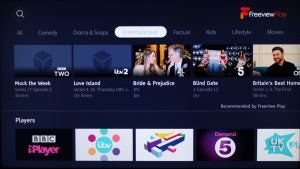
The smart platform also includes a web browser, and it supports DLNA, allowing you to access content on your home network. The 65U7A handled the majority of files I tried including MP3, MKV, AVI, WMV, MPEG and MOV.
Hisense 65U7A – Picture performance
The Hisense 65U7A delivers a solid performance with SDR content, producing bright, colourful and detailed images. The processing in the TV is actually rather good, allowing lower-resolution content to be upscaled to match the 4K panel without introducing any visible artefacts.
Black levels are reasonably good, by virtue of using a VA panel, and thanks to some effective local dimming those blacks are improved without introducing visible artefacts. The black bars on movies looked suitably black, and the local dimming remained good – even in a darkened room, with minimal haloing.
The only problem that the TV has relates to the location of the LEDs along the bottom of the screen, which could result in columns of light. How noticeable this is will depend on the content – white credits against a black background, for example – and the backlight brightness setting.
The backlight uniformity is good, although there was a small amount of banding and some slight ‘dirty screen effect’. However, overall the 65-inch panel was fairly clean and free of unwanted clouding, despite the LEDs being along the bottom.
While using a VA panel does improve the black levels, it also means the viewing angles are quite narrow. As a result, you’ll see a drop in contrast and colour saturation as you move off-axis.
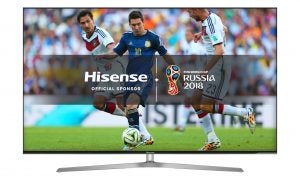
The Ultra Smooth Motion feature offers a number of different settings: Standard, Smooth, Film, and Clear. If you’re watching a film or a TV drama, I’d recommend using the Film setting, which doubles the frame rate but doesn’t use frame interpolation. That way, 24p and 50Hz content is displayed without any judder, stutter or other issues, and doesn’t suffer from the ‘soap opera effect’.
Where the Standard, Smooth and Clear settings care useful is with fast-paced sports action. The World Cup was the perfect opportunity to test the motion on the 65U7A, and rather appropriately it looked very good. In fact, football was impressive in general, with plenty of detail, bright images, vibrant colours and no obvious banding on the pitches.
The auto sport detect feature is very clever; I’m not sure how it actually works, although I assume it uses metadata. Personally, I wouldn’t use the Sports mode, but if it’s a setting you like then having the TV automatically go into it is useful.
Movies also impressed, and the better the source, the more impressive the image. Watching a good-quality Blu-ray such as Jurassic World revealed plenty of fine detail, thanks to the excellent scaling. Blacks were solid, highlights free of clipping, and the colours were suitably saturated. The result is a TV that’s capable of playing in the big leagues, at least where SDR is concerned.
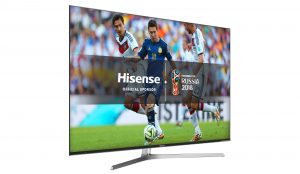
Why was this? Well, to put it bluntly: HDR performance was poor. The peak highlights were only briefly capable of about 700 nits before suddenly dropping to 230 nits in tests. The wide colour gamut was fairly limited, too, and the tone mapping resulted in some obvious clipping. You could try using the Dynamic HDR mode, but the increased brightness isn’t enough to offset the other issues that mode introduces, so I’d use the Cinema Day mode.
As a result of these issues, HDR images lacked the impact I’d expect, robbing movies, TV shows, and games of that wow factor. In fact, HDR content often didn’t look much better than its Full HD counterpart when comparing a Blu-ray to the same Ultra HD Blu-ray. It’s a similar problem for HDR on Netflix and Amazon, as well as the few HDR games I have.
Of course, you’ll still get the benefit of 4K resolution, and despite not using a native 10-bit panel, images appeared even with no sign of colour banding or gradation. In the end, whether the HDR is a big issue will depend on how much importance you place on that feature, because if it’s a priority then this isn’t the TV for you.
Related: Best TV Deals
Hisense 65U7A – Audio performance
The sound quality of the Hisense 65U7A was actually fairly decent, primarily thanks to the big 65-inch screen size and solid build quality. The TV has stereo speakers with 15W of amplification each, and the larger screen size allowed for a more open front soundstage.
The slightly wider chassis near the bottom provided room for the speakers, but their downward-firing configuration meant that the sound lost some of its immersion. However, the mid-range displayed some bite, and higher frequencies were also handled well.
The woofers built into the rear of the panel help with low-end extension, adding a bit more bass to proceedings. The Hisense could go reasonably loud without distorting, and dialogue remained clear and focused on the screen.
The 65U7A supports Dolby Digital Plus, and includes dbx-tv audio enhancement, lip sync, a user equaliser, and a number of sound modes (Standard, Theatre, Music, Speech, Late Night, and Sports). There’s also the option to select Dolby Digital or PCM via the digital audio output.
Ultimately, the 65U7A’s built-in sound quality is sufficient for basic TV watching. However, if you want something a bit more immersive for movies and big sporting events, then you should consider investing in a decent soundbar.
Hisense 65U7A – Settings
The Hisense 65U7A has a number of different picture modes including Standard, Cinema Day, Cinema Night, Dynamic and Sports. The TV ships in the Standard mode and many users will be perfectly happy with this choice, appreciating the brighter images and more saturated colours.
The Dynamic and Sports modes are too bright and oversaturated for my tastes, with very blue whites and an excessive amount of processing being applied to the image. I’d suggest avoiding these modes and sticking with Standard, although whites are still quite blue in this mode, so you might want to change the colour temperature to something a little warmer.
If, like me, you’re the kind of person that likes to watch content as the creator intended, then the two Cinema modes are closest to the industry standards, and are both quite accurate. As such, you could use Cinema Day with a brighter setting for viewing when there’s a lot of ambient light in the room, and then use Cinema Night for viewing in the evening when the room is darker.
Hisense has also added a Gamma setting, so I’d recommend using 2.2 for the Day mode, and 2.4 for the Night.
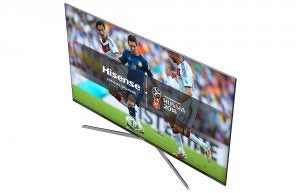
Whichever mode you choose, make sure that Ultra Smooth Motion is turned off when watching movies or TV dramas; otherwise, they can look like cheap video. Conversely, this mode can be quite useful with sport.
Finally, if you’re planning on gaming then simply select your preferred picture mode, and then turn on Game mode. This will bypass all the unnecessary video processing, ensuring the lowest input lag for gamers who like to keep their response times as fast as possible.
Why buy the Hisense 65U7A?
The Hisense 65U7A delivers exceptional value when you consider its build quality, smart features and performance with SDR content. Sound quality, too, is surprisingly good, while an input lag of 31ms should keep most gamers happy. Only a mediocre performance with HDR ruined what was otherwise a solid first-team performance.
If you’re looking for alternatives, you’ll find it hard to pick up a decent 65-inch TV for anything approaching this price. Certainly none of the new 2018 models from Hisense’s competitors get anywhere near the 65U7A’s ballpark, which means you’d need to go for a model from last year, if you can find one.
Verdict
There isn’t another 65-inch TV that gets anywhere near the 65U7A in terms of performance and value, so if you’re on a tight budget then this TV could be a tournament winner.
How we test televisions
We test every TV we review thoroughly over an extended period of time. We use industry standard tests to compare features properly. We’ll always tell you what we find. We never, ever, accept money to review a product.


